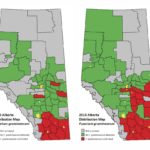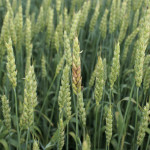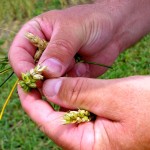Reading Time: 2 minutes Although it’s likely too late to apply a fungicide for fusarium graminearum, producers can still use the information they gather about the outbreak to plan for subsequent growing seasons. Fusarium graminearum is considered the most important fusarium head blight (FHB) species due to its aggressiveness and production of deoxynivalenol or DON (a.k.a. vomitoxin), said crop […] Read more

Now is the time to create next year’s battle plan for fusarium
Scouting this year is the first step in limiting the impact of the cereal disease next year

Fusarium risk map launched in Alberta
Available on weatherdata.ca, the information is a tool to help producers decide whether fungicide is needed
Reading Time: 2 minutes The provincial government has launched a mobile-friendly tool that will allow cereal producers to measure their fusarium head blight risk. “Fusarium became a huge issue in Alberta last year,” said Brian Kennedy, grower relations and extension co-ordinator at Alberta Wheat Commission, which also worked on the tool. “It’s been sneaking up on the province for […] Read more

Fusarium is tough, but you can fight back, says crop scientist
Planting winter wheat and bumping seeding rates can help, but fungicides aren’t a silver bullet
Reading Time: 3 minutes The forecast is for more fusarium — and possibly a lot more if it’s another wet year. “As you know, the severity and incidence of fusarium is actually on the rise — if we continue to get the weather that we’re getting, we can expect the same,” Agriculture Canada research scientist Brian Beres said during […] Read more

Even a dry year didn’t slow fusarium’s invasion
Many expected fusarium levels to drop last year, but instead it spread east and north and was worse in the south
Reading Time: 3 minutes Despite dry weather in 2015, fusarium head blight was found in almost twice as many counties as it was in 2010. A province-wide survey conducted by provincial scientists detected fusarium graminearum — the pathogen that causes fusarium head blight in cereals — in 22 counties in Alberta, up from 13 counties in the 2010 survey. […] Read more

Don’t let down your guard when it comes to fusarium
Provincial crop specialist says seed testing and using seed treatment are critical
Reading Time: 2 minutes Fusarium head blight outbreaks can cause significant losses in grain yield and grain quality, while also resulting in the production of mycotoxin-Deoxynyvalenol that affects livestock feed, the baking and milling quality of wheat and the malting and brewing qualities of malt barley. That’s why producers need to be vigilant, even if its rate of infection […] Read more

No ‘silver bullets’ for fusarium — but you can reduce your risk
Longer crop rotations, resistant varieties, and — as a last resort — fungicides are the partial weapons in a weak arsenal
Reading Time: 4 minutes When it comes to fusarium head blight, cereal growers tend to suffer from NIMBY syndrome — ‘not in my backyard.’ “Over the years, we’ve heard many comments that ‘it’s a Manitoba problem — it’ll never be a problem here in Alberta,’” federal research scientist Kelly Turkington said at the recent Agronomy Update conference. “But in […] Read more

Alberta Wheat Commission funds research
Reading Time: < 1 minute The Alberta Wheat Commission is investing $970,000 over five years in 13 wheat-related research projects. Projects include: effectiveness and appropriate timing of plant growth regulators; fusarium head blight resistance in spring wheat; development of soft white spring and general purpose spring wheat with higher yield potential; influence of genotype, weather, growing environment, and crop management […] Read more

Fusarium graminearum survey underway
Reading Time: < 1 minute Alberta Agriculture and Forestry is conducting a survey on Fusarium graminearum to help better manage the disease. “For example, if you’re trying to prevent the introduction of the organism in an area, there are certain things you can do, but if it’s already there, the prevention practices aren’t going to work,” said provincial plant pathologist Michael […] Read more

